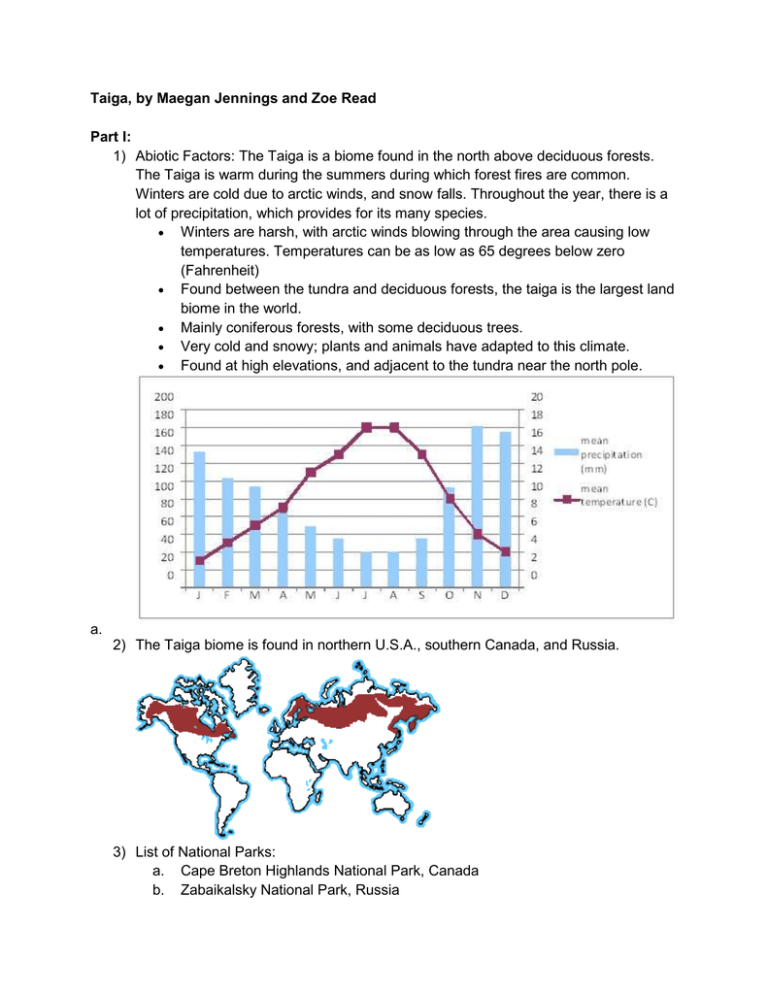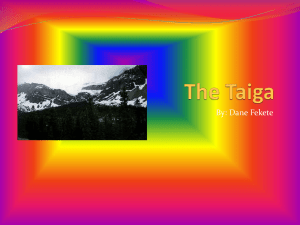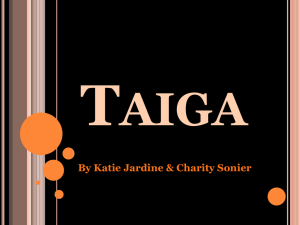taiga (1)
advertisement

Taiga, by Maegan Jennings and Zoe Read Part I: 1) Abiotic Factors: The Taiga is a biome found in the north above deciduous forests. The Taiga is warm during the summers during which forest fires are common. Winters are cold due to arctic winds, and snow falls. Throughout the year, there is a lot of precipitation, which provides for its many species. Winters are harsh, with arctic winds blowing through the area causing low temperatures. Temperatures can be as low as 65 degrees below zero (Fahrenheit) Found between the tundra and deciduous forests, the taiga is the largest land biome in the world. Mainly coniferous forests, with some deciduous trees. Very cold and snowy; plants and animals have adapted to this climate. Found at high elevations, and adjacent to the tundra near the north pole. a. 2) The Taiga biome is found in northern U.S.A., southern Canada, and Russia. 3) List of National Parks: a. Cape Breton Highlands National Park, Canada b. Zabaikalsky National Park, Russia c. Nahanni National Park, Canada 4) Discover here meese and geese trudging through the snow, striding through the tundra going towards a secret, come and you shall know. 5) To the tune of “Mickey Mouse” Taiga, Taiga Mickey, Mickey Spruce and Pine you’re so fine Spruce and Pine you’re so fine All trees in line you blow my mind The Taiga hey Mickey Snow, Snow hey hey And Taiga. hey Mickey Part II: 1) 3 Kingdoms: Animalia: American Black Bear Bald Eagle Bobcats Northern Lynx Gray Wolf (Timber Wolf) Grizzly Bear Long-eared owl Red Fox River Otter Showshoe Rabbit Wolverines Moose Siberian tigers Plantae: Black Spruce Balsam Fir Douglas-fir Eastern Red Cedar Jack Pine Paper Birch Siberian Spruce White Fir White Poplar White Spruce Fungi: Bracket Fungus Razor Strop Fungus 2) 3 Adaptations: Conical shape of firs, spruces, and pines: Allows snow to slide off easily so that branches are not broken, as it snows frequently in the taiga. The Needleleafs reduce surface area and water loss. This is helpful when the ground freezes and the trees have difficulty extracting water from it. The evergreen nature of many of the trees allows them to begin photosynthesizing early, as they do not have to wait and grow leaves when the temperature warms. The dark color of the trees also allows them to absorb greater sunlight and heat in the cold and to start photosynthesizing early. 3) Food Chains: green leaves from clover >>> grouse >>>bobcats grass >>> vole >>> long-eared owl >>> golden eagle plant matter (grass) >>> river otter >>> red fox 4) Food Web: 6) Ecological Pyramid 1st Trophic Level (Producers): Grasses, Clover, Aspen Tree 2nd Trophic Level (Primary Consumers): Snail, Vole, Grouse 3rd Trophic Level (Secondary Consumers): River Otter, Long-eared owl, Bobcat 4th Trophic Level (Tertiary Consumers): Red Fox, Golden Eagle Part III: 1) Mutualism is found in the Taiga relationship between owls and trees; the owl is able to roost in the tree, and when the owl excretes its fecal waste, it’s nutrients go into the tree. 2) Commensalism in the Taiga is exemplified in the relationship between seed producing trees and seed eating animals, the animal can benefit from eating the seed and the tree is neither hurt nor helped. 3) An example of parasitism in the Taiga is fungus growing on trees; the fungus grows on the tree and slowly kills it by robbing the tree of nutrients without giving anything to the tree in return. 4) Competition for resources and food is found in the Taiga in interspecies competition for grasses during the winter. This is because in populations of herbivores in the winter, all of the members of a population have to compete to get food. Part IV: 1) Endangered, threatened, or extinct species The wolverine is endangered. These species become endangered as they lose their habitat, the boreal forest, to logging. These areas provide them with the animals and protection they need for survival. 2) Environmental Issue: An environmental issue which threatens the taiga is the clearcutting of forests for wood to make wood products. Clearcutting removes all trees from an area, absolutely eliminating taigan animal’s habitats. This also exposes the soil and allows it to be eroded, exposing permafrost and bedrock, which are not very supportive of life. This issue could be resolved by prohibiting the practice of clearcutting and requiring loggers to cut small areas and then replant the trees. Sources: http://www.blueplanetbiomes.org/taiga_animal_page.htm http://www.nhptv.org/natureworks/nwep8b.htm http://kids.nceas.ucsb.edu/biomes/taiga.html http://education.nationalgeographic.com/education/encyclopedia/taiga/?ar_a=1 http://biomesfifth09.wikispaces.com/Taiga+Home http://explorebiodiversity.com/habitats/boreal.html http://www.ucmp.berkeley.edu/glossary/gloss5/biome/tundra.htmlhttp://www.adfg.alaska.go v/static/hunting/smallgamehunting/pdfs/alaska_grouse_ptarmigan.pdf http://www.dnr.state.mn.us/birds/ruffedgrouse.html http://animals.pawnation.com/habitat-taiga-vole-3740.html http://www.biokids.umich.edu/critters/Asio_otus/ http://ladywildlife.com/animals/gardensnail.html http://www.animalcorner.co.uk/biomes/boreal.html http://www.pellotsaari.ru/en/3734/3945/3985/ https://biomessixth10.wikispaces.com/Taiga+Facts http://biomesfourth.wikispaces.com/Taiga+Facts Pictures: http://www.borealforest.org/world/herbs_shrubs/sweet_grass.htm http://citadel.sjfc.edu/students/aac01774/e-port/taiga.html http://2.bp.blogspot.com/iZJxVV99Dt4/UAsHINT024I/AAAAAAAABrE/Fr4oleZjO2A/s400/red-clover-white-clover.jpg http://www.birdholidays.co.uk/manitoba/sage%20grouse.jpg http://2.bp.blogspot.com/Q6Ct2KLsk9k/TxyE51H5wqI/AAAAAAAAAr8/M6tbrn8cgbc/s400/Field+Vole.jpg https://biomessixth10.wikispaces.com/Taiga+Facts http://www.myschoolisgreat.org/Bird_pages/golden_eagle.jpg





